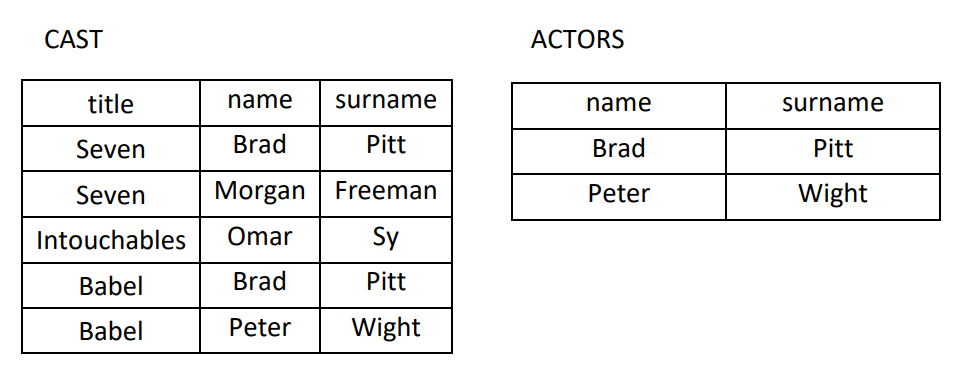$ \newcommand{\Set}[2]{% \{\, #1 \mid #2 \, \}% }$
I've been trying to find how to express relational division operation in tuple relational calculus. The only thing I found is this presentation where on the page 4 it is said that for relations $R = (A, B)$ and $S = (B)$ the division is
$$ R \div S \equiv \Set{t}{\exists p \; \forall q \; (R(p) \land S(q) \land (p.B = q.B \Rightarrow t.A = p.A))}. $$
Which I find to be completely wrong. Let me first show why I think it's wrong and then propose my own solution.
Let's have tables
We want to find movies in which all actors played - meaning $\mathrm{CAST} \div \mathrm{ACTORS}$. Correct solution is a relation with only one attribute: $(\mathrm{Babel})$.
If we followed the given interpretation we would quickly run into a problem.
Let $t = (\mathrm{Seven})$ in the first table. We test whether we can find a $p$ from $\mathrm{CAST}$ such that ${(p.\mathrm{name} = q.\mathrm{name} \land p.\mathrm{surname} = q.\mathrm{surname}) \Rightarrow t.\mathrm{title} = p.\mathrm{title}}$ for all $q$'s from $\mathrm{ACTORS}$.
Let $p = (Seven, Brad, Pitt)$ and let's try all the $q$'s:
For $q = (Brad, Pitt)$ we get $true \Rightarrow true$ which is $true$.
For $q = (Peter, Wight)$ we get $false \Rightarrow true$ giving $true$.
So the $t = (Seven)$ will appear in the resulting relation even though it's the incorrect tuple (i found a $p$ such that for all the $q's$ the condition is satisfied).
I first tried to convert the relational algebra equivalent $$ E_{R} \times E_{S} = \Pi_{A}(E_{R}) \setminus \Pi_{A}((\Pi_{A}(E_{R}) \times E_{S}) \setminus E_{R}), $$ but it resulted in an extremely complicated result with 4 bound variables so I ruled that way out as well.
The last thing I resorted to is my intuition. Not only was the implication wrong in the aformentioned formula but also the order of quantifiers - for a given $t$ there cannot be a single $p$ such that $p.B = q.B$ for multiple $q$'s at the same time since the $\mathrm{Actors}$ relation cannot contain duplicit tuples.
My shot at this:
We want to find all tuples $t$ from the $\mathrm{CAST}$ such that for every $q$ from $\mathrm{ACTORS}$ I can find a $p$ in the $\mathrm{CAST}$ having the same $\mathrm{name}$ and $\mathrm{surname}$: \begin{align} \begin{gathered} \Set{t}{\forall q \; \exists p \; (\mathrm{ACTORS}(q) \land \mathrm{CAST}(p) \, \land \\ p.\mathrm{name} = q.\mathrm{name} \land p.\mathrm{surname} = q.\mathrm{surname} \land t.\mathrm{title} = p.\mathrm{title}))} \end{gathered} \end{align} Is that correct?

